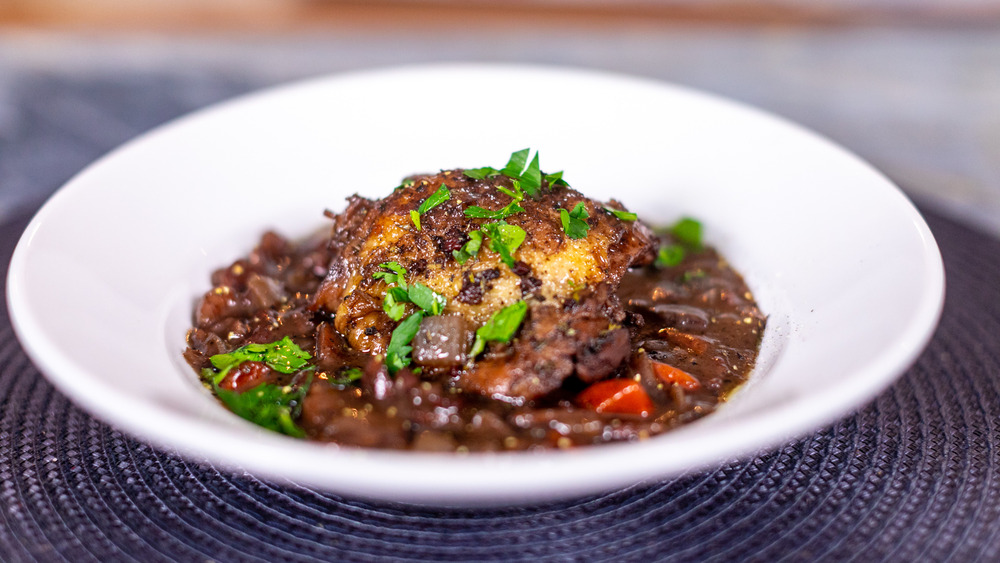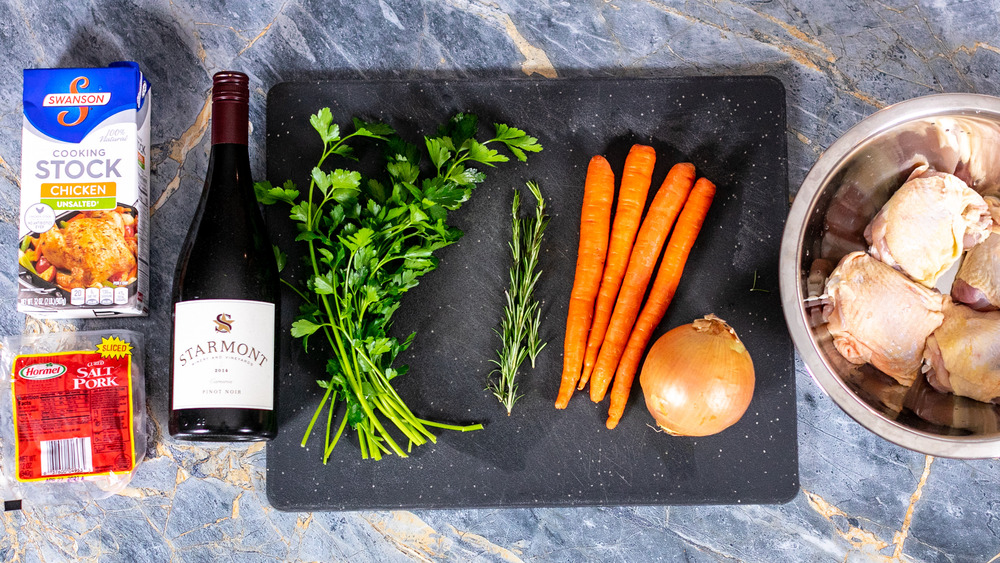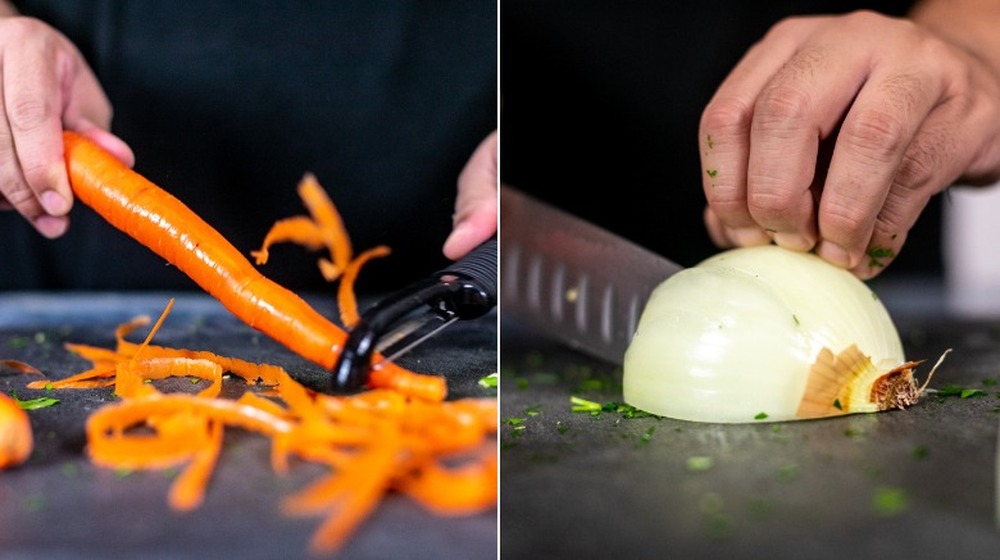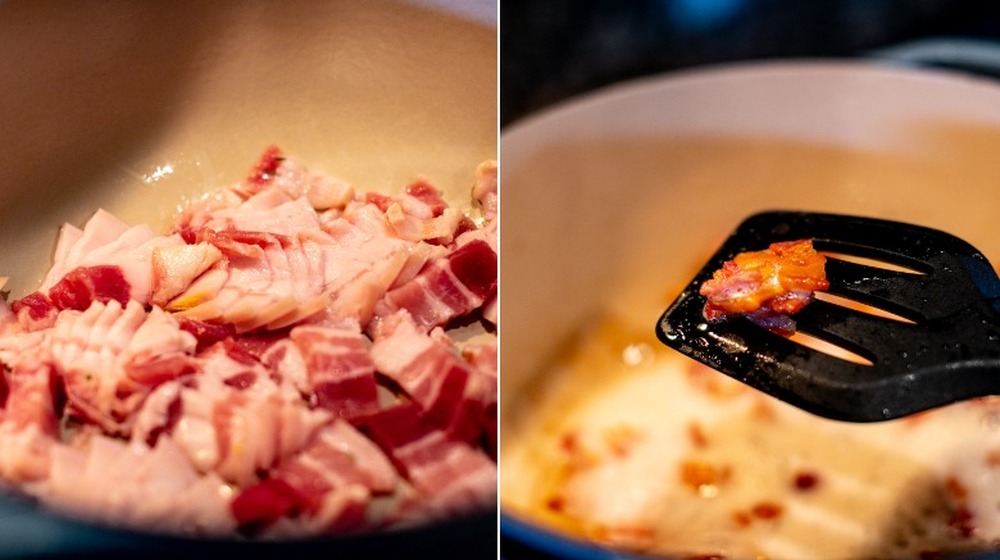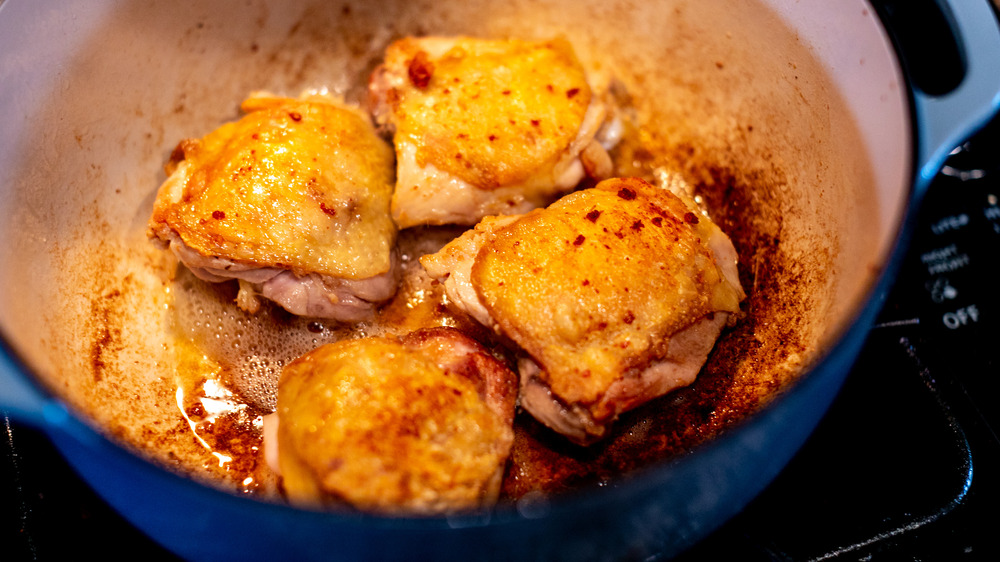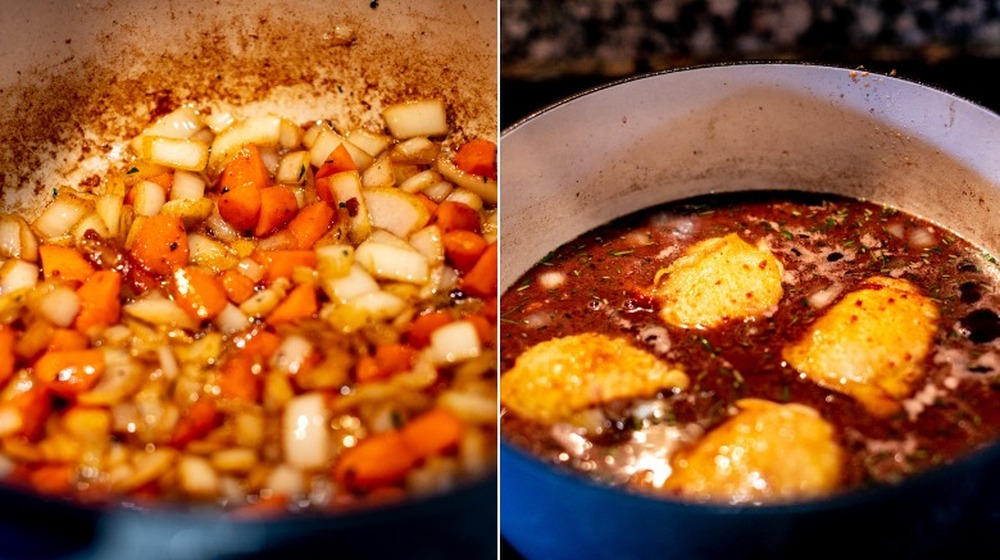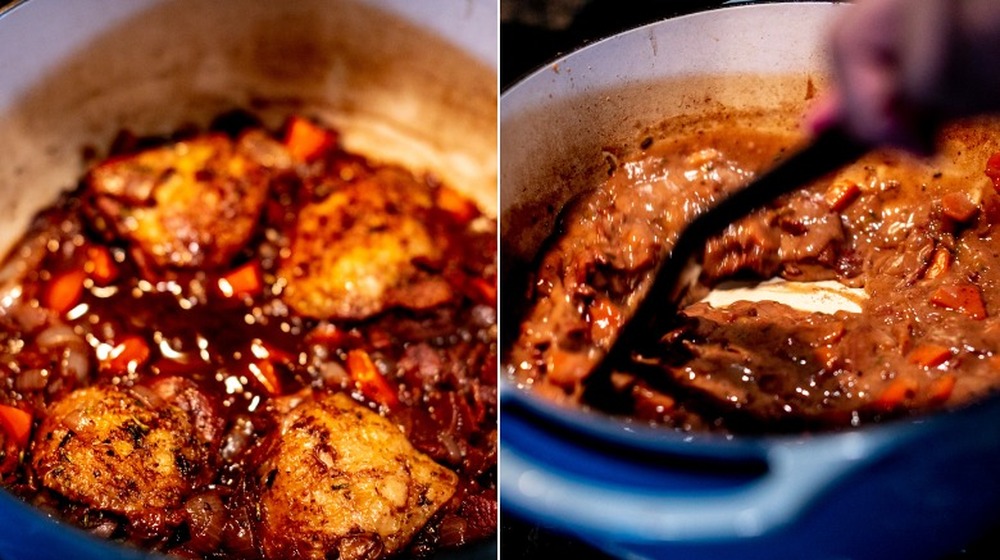Easy Coq Au Vin Recipe
Coq au vin is a classic French dish that everyone should have in their cooking repertoire. As recipe developer Nathaniel Lee says on his website, Beginner Food, "Great meals don't need to be complicated or scary." And he's right. His recipe for coq au vin is easy, quick, and great for any night of the week. Coq au vin (pronounced "coke-oh-ven") translates to "rooster in wine" because early recipes used wine to tenderize tough old birds in a stew. Its origins are mysterious, but Julia Child made coq au vin famous by including its recipe in her cookbook Mastering the Art of French Cooking and preparing it on "The French Chef" (via finedininglovers.com). Coq au vin is similar to Child's other acclaimed recipe for beef bourguignon, which is exceedingly delicious but time-consuming. Lee hones down coq au vin to its simplest form without losing any of the dish's robust flavor. This really is high-end French restaurant food made simple.
Gather together the ingredients for this coq au vin recipe
The chicken and wine are the star ingredients in coq au vin, although salt pork plays an important supporting role. Let's start with the chicken. Since it will be simmered for 30 minutes, it's better to use chicken thighs, not only because they're more flavorful, but they also stay juicy when braised, baked, or broiled. If you prefer to use chicken breast, you'll need to cut them so they're the same size, and reduce the simmering time to avoid having them dry out and get stringy. Drumsticks are also excellent for coq au vin, and they'll cook the same way and in the same amount of time as the thighs. For the wine, Lee recommends a burgundy or a pinot noir varietal. Buy a good red wine, not a cheapo cooking wine, which will give the coq au vin's sauce a harsh, bitter taste. Salt pork is a traditional ingredient for both coq au vin and beef bourguignon. It's much saltier than bacon, which is often substituted for salt pork. Bacon, though, adds a smoky flavor, unless you blanch it first. Another good substitution that Lee suggests is pancetta, the unsmoked Italian bacon.
Prep the veggies and herbs for the coq au vin
There isn't much prep for Lee's coq au vin, which is always helpful when you need to get dinner on the table in a jiffy. You may think that peeling the carrots before chopping them just gives you pretty carrots. And it's true, peeled carrots make a nice presentation. But there's a practical reason too. Carrots have a protective layer that protects them while they're growing in the ground. When it's cooked, that layer shrivels and turns bitter, thus ruining the carrots' natural sweetness. So use a vegetable peeler, and peel the carrots first – it will take you only two minutes, tops! Peel the skin off the onion, and chop it into about 1/2-inch diced pieces. Italian parsley has a pronounced herbal flavor that will balance the richness of the final dish. But it's okay to use curly parsley too. Whichever you choose, rough chop it, and set it aside for later. Finally, strip the rosemary sprigs of their leaves by holding the stem at the tip and then pulling the leaves downward – they'll come right off in your hand. Give them a fine chop because rosemary is sturdy and doesn't always cook as quickly as other herbs.
Slice and sauté the salt pork for the coq au vin
Coq au vin always has pork as an ingredient, which, when cut into matchsticks, French chefs call lardons. Lardons flavor many classic French dishes, but they're also woven into lean meat to prevent it from drying out. You'll make your own lardons by simply cutting up the salt pork into 1/4-inch-wide strips. Transfer the strips to a Dutch oven or large skillet, and sauté them for 10 minutes over medium-high heat. While sautéing, separate the strips so they cook evenly. When the salt pork is golden brown, remove the strips with a slotted spoon or spatula, and set them aside. Salt pork will render a lot more fat than bacon, so when it's cooked, drain off half, and pour it into a disposable container, which you'll then toss in the trash. You can also pour the fat into a small bowl, let it cool and congeal, and then scrape it into the trash. Your kitchen drain and pipes will thank you for it!
Sear the chicken thighs in the rendered pork fat
Increase the heat to high, and lay the chicken skin-side down in the pan. Depending on the size of your pan, or if you're doubling the recipe, you may need to sear the chicken in a couple of batches. Cook for 3 to 4 minutes until the skin crisps up and most of the chicken fat has been rendered. Use tongs to turn the chicken over, and sear the other side for another 3 to 4 minutes. The chicken will still be pink inside, but it will finish cooking when the other ingredients are added later. Transfer the chicken to a plate, and if you're cooking a second batch, repeat the same steps. There may be quite a bit of fat in the pan, and you'll need a few tablespoons for sautéing the vegetables. But if it seems like too much, then drain some of it out.
Brown the vegetables, add the chicken and wine, and simmer
Now add the chopped carrots and onions to the rendered pork fat, and sauté them for 5 minutes, until they're starting to soften and have taken on color. Stir in the chopped rosemary, then pour in the wine. Keep stirring with a wooden spoon to deglaze the pan and then add the chicken stock. Use the spoon to scrape up the browned bits from the bottom of the skillet — every little bit is a flavor bomb, so try to get as much scraped off as possible. Scatter the cooked salt pork evenly, then transfer the chicken back to the pan, skin-side up. Try not to submerge them in the cooking liquid, since you want to retain the skin's crispy texture and rich golden color. Cover the pot, lower the heat, and simmer the chicken for 30 minutes.
When the chicken is done, make a roux, and serve
When the chicken is done, remove it with tongs, and set aside on a plate. A frequently used French method for thickening a sauce is a beurre manié, which is nothing more than softened butter and flour mashed together with a fork or your fingertips that you then whisk into cooking liquid to turn it into a gravy. Lee uses a roux instead. Put 2 tablespoons of butter into a small bowl, and microwave for 15 seconds. Add 2 tablespoons of flour to the butter, and combine them until they're a smooth paste. Stir the roux into the cooking juices over medium heat for 5 minutes, and it will thicken into a silky sauce. You're now ready to serve. Ladle the sauce into each plate or wide bowl, and place a piece of chicken on top. Garnish with the chopped parsley and some cracked pepper. And voilà, there you have it! A classic French meal you might think Julia Child herself had prepared. Serve it with the same wine you used to braise the coq au vin, and enjoy!
Coq au vin
If you've been too nervous to try making coq au vin at home, fear not! Not only is this recipe super tasty, it's also incredibly easy to make.
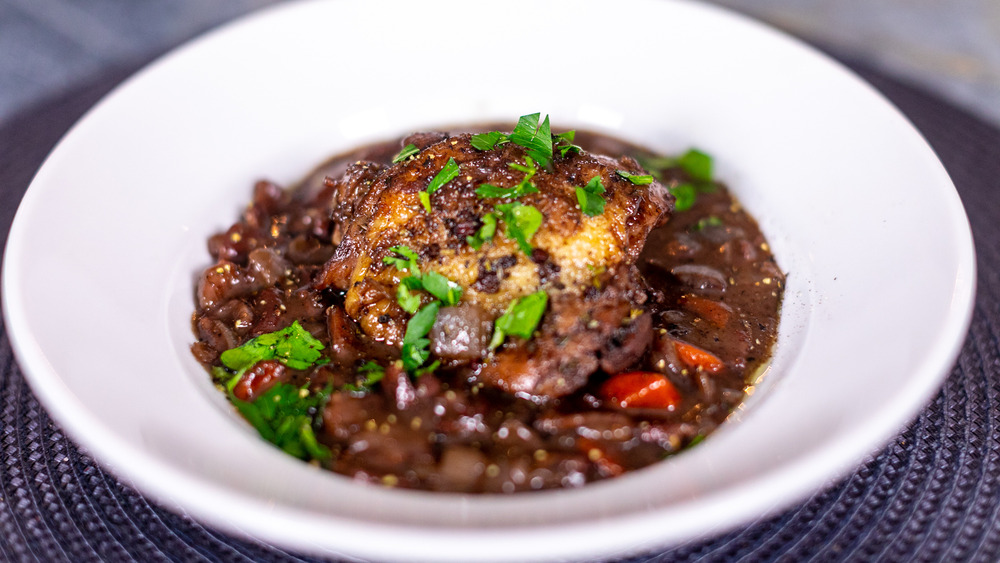
Ingredients
- 4 medium carrots
- 1 medium onion
- 3 sprigs fresh rosemary
- 1/2 cup Italian or curly parsley
- 12 ounces salt pork (or bacon or pancetta)
- 11/2 pounds chicken thighs (skin on)
- 2 cups red wine
- 2 cups chicken stock
- 2 tablespoons butter
- 2 tablespoons flour
Directions
- Use a vegetable peeler to peel the carrots. Chop the carrots into 1/2-inch pieces. Peel and dice the onion.
- Strip the rosemary leaves off the sprig, then finely chop the leaves. Roughly chop the parsley and set aside for the garnish.
- Cut the salt pork into strips 1/4-inch wide. Add the salt pork to a Dutch oven, and cook on medium-high heat until golden brown and crisp.
- Remove the salt pork with a slotted spoon, and set aside. Drain half of the rendered pork fat and discard.
- Increase the heat to high, and add the chicken thighs to the Dutch oven. Sear the chicken in the pork fat for 3 to 4 minutes on each side, until golden. Transfer the chicken to a plate.
- Add the chopped carrots and onions to the pot, and sauté 5 minutes. Stir in the chopped rosemary.
- Pour in the wine to deglaze the pot by scraping up the brown bits with a wooden spoon, and then add the chicken stock.
- Add the cooked salt pork to the pot, then lay the chicken thighs on top, skin-side up so the skin is above the liquid.
- Cover and simmer 30 minutes. Remove the chicken and transfer to a plate.
- To make the roux for the sauce: If the butter is still cold, soften it in a small bowl in the microwave for 15 seconds. Add the flour to the butter, and stir with a fork until it's combined.
- Add the roux to the pot, and stir over medium heat for 5 minutes, until the sauce thickens.
- To serve: Ladle some sauce onto a plate, then place the chicken on top. Garnish with the chopped parsley and cracked pepper.
